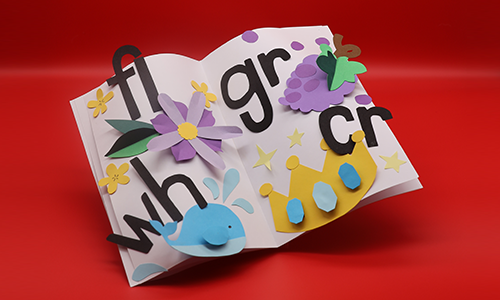
We all want children to be able to read well so they can read all kinds of texts for understanding. How does this happen? What are the basic moving parts that describe how students learn to read with comprehension? Let’s look at decoding, language comprehension, fluency, and reading comprehension.
The Simple View of Reading
The National Reading Panel framed reading instruction as encompassing five areas: phonemic awareness, phonics, fluency, vocabulary, and text comprehension. These fall under the broader categories of word-recognition skills and language-comprehension skills. Word recognition and language comprehension come together as students learn to read fluently and with comprehension.
The National Reading Panel based its framework on the Simple View of Reading, which posits that reading with comprehension (RC) is essentially the product of word recognition (WR) proficiency and language comprehension (LC), summarized in the formula RC = D x LC.
 The multiplication in that formula is important because it means that any insufficiency in either word recognition or language comprehension will suppress a student’s overall reading comprehension. Imagine a student is at full power in word recognition—100%, or 1.0—but is only at half power in language comprehension. The product of the two numbers is 50%, or 0.5. The Simple View of Reading asserts that we cannot make up for a weakness in one factor just by strengthening the other.
The multiplication in that formula is important because it means that any insufficiency in either word recognition or language comprehension will suppress a student’s overall reading comprehension. Imagine a student is at full power in word recognition—100%, or 1.0—but is only at half power in language comprehension. The product of the two numbers is 50%, or 0.5. The Simple View of Reading asserts that we cannot make up for a weakness in one factor just by strengthening the other.
Word recognition
Word recognition is the task of turning sets of letters on the page into the sounds they represent. Ultimately, it involves bringing sounds and graphic representations together. Before this can happen, students need to be able to hear and distinguish sounds, and they need to be able to identify letters.
On the sound side, word recognition involves working with the spoken word and noticing syllables, rhyming, and individual sounds, or phonemes. Phonological awareness is about a student’s ability to work with sounds.
On the graphic representations side, the word recognition process begins with learning letters and continues with learning sets of common letter patterns. Systematic instruction in connecting these letter patterns to sounds in words is referred to as phonics. As students learn to decode words on the page, they grow more sophisticated at relating letter patterns to sounds. Gradually, word recognition becomes more and more automatic.
Word recognition ability is necessary for reading, but on its own, it is insufficient for learning to read with comprehension. Students may recognize words on the page without understanding what they read.
Language comprehension
Imagine a teacher or parent reading to a child and the child listening and taking in meaning. It is common for students to understand what is read aloud while still being unable to decode it on their own. This process is language comprehension. In the Simple View of Reading, the two must come together: the ability to recognize words and the ability to make meaning of the language we “hear” when we identify a word.
Language comprehension rests not just on knowing a wide body of word meanings, including words with multiple meanings and idioms, but also on understanding the structure of sentences and beyond; our understanding of grammar lets us know how to relate words’ meanings. For example, it is our knowledge of grammar that helps us determine whether the word “read” is being used in the present or past tense. Even before they can read independently, students need to develop strong listening comprehension to foster good reading comprehension in later years. When a student needs to improve language comprehension but doesn’t receive support or instruction in that area, future reading comprehension is likely to be more challenged.
Fluency
As students gain skills in reading individual words, they begin to work with connected text—that is, sentences and passages. As they tackle passages, they show increases in their rate, accuracy, and expression in reading aloud. Together, these three factors make up reading fluency. Students who are able to read aloud fluently have more automatic word recognition, which means they have less need to focus on sounding out each word. This frees up mental space for attending to the meaning of those words.
When students start to string together phrases and sentences from the page, they typically draw from their own language proficiency in figuring out which words make sense. This process is the beginning of pulling word recognition (WR) and language comprehension (LC) together. The Simple View of Reading says that when these two factors come together adequately, reading comprehension can occur. This model explains an important research finding: in the primary grades, students’ reading fluency strongly predicts their reading comprehension.
Reading comprehension
As students start to string together phrases and sentences from the page, they typically draw from their own language proficiency in figuring out which words make sense. This process is the beginning of pulling word recognition (WR) and language comprehension (LC) together. The Simple View of Reading says that when these two factors come together adequately, reading comprehension can occur.
When students read a text on their own and make meaning from it, they demonstrate reading comprehension. Fluent reading with good expression, accuracy, and pace suggests some understanding, but reading comprehension is a robust concept that goes well beyond literal comprehension. State standards typically specify skills in areas such as understanding relationships between ideas, inference-making, and author’s purpose and craft. In the primary grades, comprehension is an area of instructional focus even before students can read independently and fluently enough to support solid reading comprehension; skills in comprehending books and other texts develop even as students rely on others to read to them aloud smoothly.
To learn about our reading assessment, MAP® Reading Fluency™, and how it can help you understand your students’ word recognition, language comprehension, and reading comprehension skills, visit our website.






